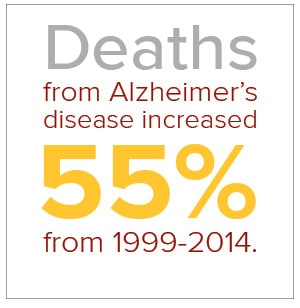Watch out for the “hockey stick.”
That’s the metaphor for the shape data takes on a chart when there’s a sharp uptick ahead. And that’s what the numbers on Alzheimer’s disease and dementia look like from this moment until 2050: going up, and fast. How can senior living leaders prepare for this abrupt spike in need for memory care? Innovative programs, community outreach and engagement, and participation in pilots and clinical trials were the top areas discussed at the Argentum Memory Care Symposium hosted in June in Washington, D.C. sponsored by MatrixCare.
Facing the wave
“The time is now to be thinking about how we’re going to be treating 10 times the number we do today,” said keynoter George Vradenburg, chairman and co-founder of UsAgainstAlzheimer’s. “Society won’t do it; taxpayers won’t do it—you’re the leading edge. So set the standards now.”

Senior living leaders can play a strong role in the search not only for a cure but also for interventions that improve quality of life for those living with memory decline. Directing resources to timely detection and diagnosis, working with communities on dementia-friendliness, promoting better integration with health care, and coordination with arts institutions and colleges were other ideas he extended.
These are win-win propositions for senior living, Vradenburg pointed out. For instance, such efforts can result in net lower cost of health care delivery in communities, or lower cost of treatments in the future.
Reaching out to diverse communities
Recognizing that people living with memory disorders are from diverse cultures and communities is key to better quality of life. Presenters in the “Memory Care & Diverse Communities: The Need for Action & Resources” panel provided a picture of some of these diverse communities and what they need.
Moderator Virginia Biggar, executive director, Patient-Caregiver, Faith and Veteran Initiatives at UsAgainstAlzheimer’s, drew attention to the group’s new initiatives focused on veterans, including outreach using technology such as online groups and podcasts, which allow a geographically widespread cultural group to share support.
Alzheimer’s is a “perfect storm” situation for America’s Latinos: They’re the fastest-growing older adult population in the United States and they’re 1.5 times as likely as whites to get the disease, pointed out Jason Resendez, executive director, LatinosAgainstAlzheimer’s Network and Coalition. The toll extends, of course, to whole families, falling particularly hard on daughters, who leave the workforce, lose years of productivity, and suffer illness and stress as they serve as caretakers. “We all basically went broke,” Resendez quoted one member of a caretaking family.
Statistics are equally troubling for African-Americans and Alzheimer’s, said Stephanie Monroe, executive director, UsAgainstAlzheimer’s African American Network. In addition, only about 40 percent
from this community get an accurate diagnosis.
Other points of interest to senior living leaders: African-American people are more likely to own their homes and to want to stay in them; and there’s more need for help in memory care in the South. But obstacles to care in this community include strong impressions that memory problems are a normal part of growing old or that it is “shameful” or “selfish” to choose residential memory care.
A similar sense that residential memory care “isn’t part of our culture” prevails in Latino communities, said Carmen Pastor, president of Fuerza Contra Alzheimer’s, who related her own experience in addressing her mother’s isolation as a result of Alzheimer’s.
“We started a Spanish club, with a festival,” she said. “My mother became the queen of karaoke,” with songs in Spanish from her own generation. Providing for religious observance (such as a small personal altar) and getting familiar flavors onto the menu also proved helpful.
Presenters also mentioned the importance of considering inclusiveness for LGBTQ people and couples in residences.
Innovation holds answers
The “Memory Care Innovations: From Idea to Implementation” panel featured practical programs that hit the center of the target: they get results now, they can be adapted to diverse residences, and they can be expanded and transformed to meet future needs.
- Unidine Corporation’s Jenny Overly, director of health & wellness innovation, presented details on implementing and advancing the Fresh Bites program, a food preparation method that brings adult flavors to finger foods—and dignity and personalization to the meal experience.
- Kristine Theurer, founder and president of Java Group Programs, Inc., countered the stereotype that peer support can’t be practiced in memory care. In fact, she’s found, it can reduce loneliness, isolation, and loss of social identity. The simple-to-implement Java Time program uses music and social events to cultivate meaningful emotional engagement—and, Theurer adds, “anyone can implement it.”
- The Alzheimer’s Resource Center Well-BEING Project starts with “appreciative inquiry:” If staff turnover is high, for instance, one could ask why people are leaving, or “I could say, ‘We’ve got people who’ve stayed for 20 years—what can we learn from that?’” explained Jenna Weiss, director of learning at the Center. The simple but illuminating approach involves techniques such as “huddles,” for instance: short, informal, small-group meetings of care partners and residents, designed to check in on choices and decisions.
- The TimeSlips Creative Storytelling approach has gained attention because of its striking creative theater work and website. But what’s more important than the finished creative projects is the process, says Anne Basting, its founder and president. Participants use pictures and photographs, as well as classic story structures, for self-expression and to interact with the community. On-site, the program requires certified facilitators and master trainers, but there’s also an online component that allows greater participation and family involvement—even global interaction. People “take pride in what they can give to the world” through their creative efforts, Basting says.
Individual residences and groups need to evaluate the fit and adaptability for these programs. But the initiatives share one important quality: They’re less dependent on a big resource investment than on a big shift in thinking.



